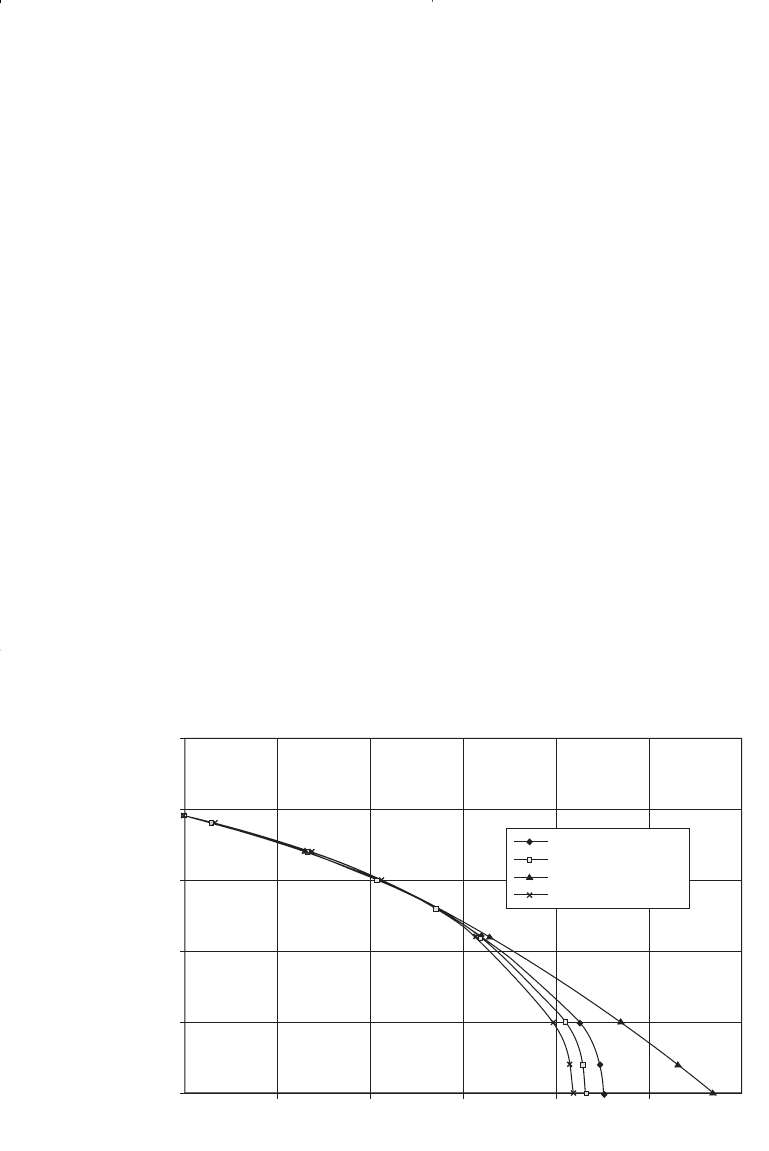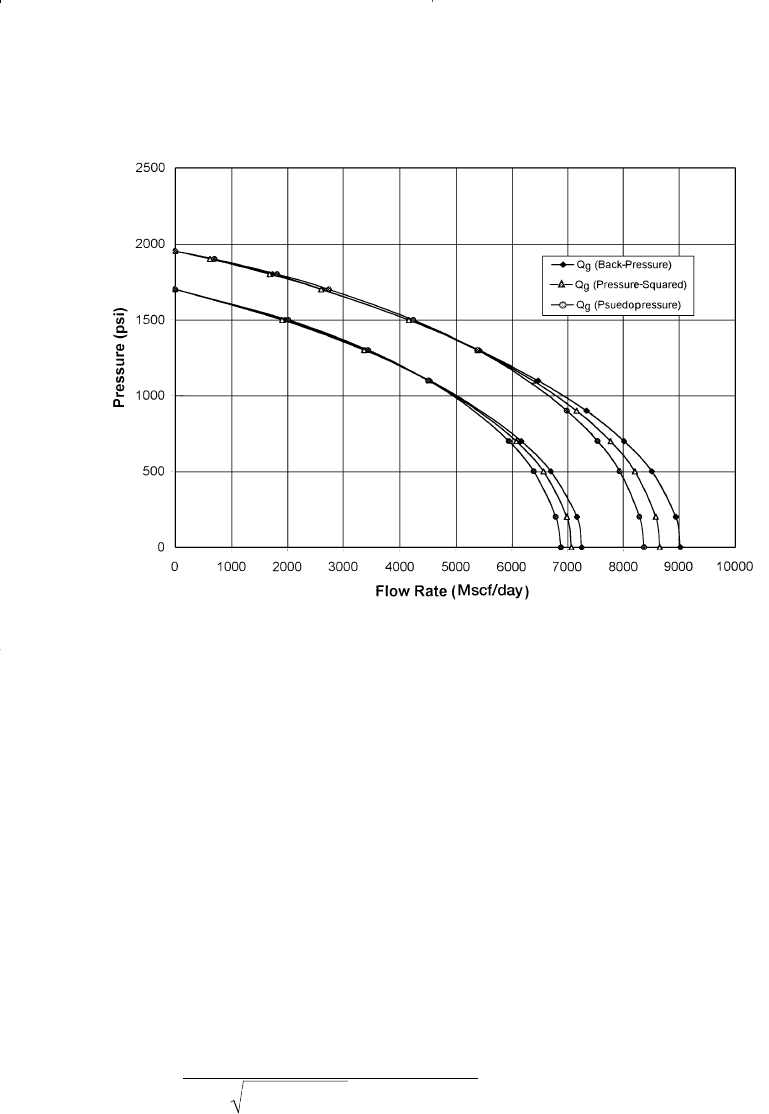Tarek Ahmed. Reservoir engineering handbook
Подождите немного. Документ загружается.


p
wf
yy
–
r
-y
wf
Q
g
, Mscf/day
1952 316 ¥ 10
6
00
1800 270 ¥ 10
6
46 ¥ 10
6
1794
1600 215 ¥ 10
6
101 ¥ 10
6
3503
1000 100 ¥ 10
6
216 ¥ 10
6
6331
500 40 ¥ 10
6
276 ¥ 10
6
7574
0 0 316 ¥ 10
6
8342 = AOF (Q
g
)
max
c. Compare the gas flow rates as calculated by the four different meth-
ods. Results of the IPR calculation are documented below:
Gas Flow Rate, Mscf/day
Pressure Back-pressure p
2
-Approach p-Approach y-Approach
19520 0 0 0 0
1800 1720 1675 1879 1811
1600 3406 3436 3543 3554
1000 6891 6862 6942 6460
500 8465 8304 9046 7742
0 8980 8763 10827 8536
6.0% 5.4% 11% —
558 Reservoir Engineering Handbook
27000
26000
0
28000
29000
30000
31000
32000
33000
1000 2000 3000 4000 60005000
Flow Rate
Differential Pressure Over Flow Rate
Figure 8-12. Pseudopressure method.
Reservoir Eng Hndbk Ch 08 2001-10-24 11:13 Page 558

Since the pseudo-pressure analysis is considered more accurate and
rigorous than the other three methods, the accuracy of each of the meth-
ods in predicting the IPR data is compared with that of the y-approach.
Figure 8-13 compares graphically the performance of each method with
that of y-approach. Results indicate that the pressure-squared equation
generated the IPR data with an absolute average error of 5.4% as com-
pared with 6% and 11% for the back-pressure equation and the pressure-
approximation method, respectively.
It should be noted that the pressure-approximation method is limited to
applications for pressures greater than 3000 psi.
Future Inflow Performance Relationships
Once a well has been tested and the appropriate deliverability or
inflow performance equation established, it is essential to predict the IPR
data as a function of average reservoir pressure. The gas viscosity m
g
and
gas compressibility z-factor are considered the parameters that are sub-
ject to the greatest change as reservoir pressure p
–
r
changes.
Assume that the current average reservoir pressure is p
–
r
, with gas vis-
cosity of m
g
and a compressibility factor of z
1
. At a selected future aver-
Gas Well Performance 559
0
500
1000
1500
2000
0
2500
2000 4000 6000 8000 1200010000
Flow Rate (Mscf/day)
Pressrue (psi)
Q
g
(Back-pressure)
Q
g
(Pressure-Squared)
Q
g
(Pressure)
Q
g
(Psuedopressure)
Figure 8-13. IPR for all methods.
Reservoir Eng Hndbk Ch 08 2001-10-24 11:13 Page 559

age reservoir pressure p
–
r2
, m
g2
and z
2
represent the corresponding gas
properties. To approximate the effect of reservoir pressure changes, i.e.
from p
–
r1
to p
–
r2
, on the coefficients of the deliverability equation, the fol-
lowing methodology is recommended:
Back-Pressure Equation
The performance coefficient C is considered a pressure-dependent
parameter and adjusted with each change of the reservoir pressure
according to the following expression:
The value of n is considered essentially constant.
LIT Methods
The laminar flow coefficient a and the inertial-turbulent flow coeffi-
cient b of any of the previous LIT methods, i.e., Equations 8-24, 8-29,
and 8-34, are modified according to the following simple relationships:
• Pressure-Squared Method
The coefficients a and b of pressure-squared are modified to account
for the change of the reservoir pressure from p
–
r1
to p
–
r2
by adjusting the
coefficients as follows:
where the subscripts 1 and 2 represent conditions at reservoir pressure
p
–
r1
to p
–
r2
, respectively.
bb
z
z
g
g
21
22
11
=
È
Î
Í
Í
˘
˚
˙
˙
m
m
(8 - 42)
aa
z
z
g
g
21
22
11
=
È
Î
Í
Í
˘
˚
˙
˙
m
m
(8 - 41)
CC
z
z
g
g
21
11
22
=
È
Î
Í
Í
˘
˚
˙
˙
m
m
(8 - 40)
560 Reservoir Engineering Handbook
Reservoir Eng Hndbk Ch 08 2001-10-24 11:13 Page 560

• Pressure-Approximation Method
where B
g
is the gas formation volume factor
• Pseudopressure Approach
The coefficients a and b of the pseudo-pressure approach are essen-
tially independent of the reservoir pressure and they can be treated as
constants.
Example 8-3
In addition to the data given in Example 8-2, the following informa-
tion is available:
• (m
g
z) = 0.01206 at 1952 psi
• (m
g
z) = 0.01180 at 1700 psi
Using the following methods:
a. Back-pressure method
b. Pressure-squared method
c. Pseudo-pressure method
Generate the IPR data for the well when the reservoir pressure drops
from 1952 to 1700 psi.
Solution
Step 1. Adjust the coefficients a and b of each equation. For the:
• Back-pressure equation:
Using Equation 8-40, adjust C:
bb
gg
gg
21
22
11
=
È
Î
Í
Í
˘
˚
˙
˙
mb
mb
(8 - 44)
aa
gg
gg
21
22
11
=
È
Î
Í
Í
˘
˚
˙
˙
mb
mb
(8 - 43)
Gas Well Performance 561
Reservoir Eng Hndbk Ch 08 2001-10-24 11:13 Page 561

Q
g
= 0.01727 (1700
2
- p
2
wf
)0.87
• Pressure-squared method:
Adjust a and b by applying Equations 8-41 and 8-42
(1700
2
- p
2
wf
) = 311.14 Q
g
+ 0.01304 Q
2
g
• Pseudopressure method:
No adjustments are needed.
(245 ¥ 10
6
) - y
wf
= (22.28 ¥ 10
3
) Q
g
+ 1.727 Q
2
g
Step 2. Generate the IPR data:
Gas Flow rate Q
g
, Mscf/day
p
wf
Back-Pressure p
2
-Method y-Method
p
–
r
= 1700 0 0 0
1600 1092 1017 1229
1000 4987 5019 4755
500 6669 6638 6211
0 7216 7147 7095
Figure 8-14 compares graphically the IPR data as predicted by the
above three methods.
HORIZONTAL GAS WELL PERFORMANCE
Many low permeability gas reservoirs are historically considered to be
noncommercial due to low production rates. Most vertical wells drilled in
tight gas reservoirs are stimulated using hydraulic fracturing and/or
b =
Ê
Ë
ˆ
¯
=0 01333
0 01180
0 01206
0 01304.
.
.
.
a =
Ê
Ë
ˆ
¯
=318
0 01180
0 01206
311 14
.
.
.
C =
Ê
Ë
ˆ
¯
=0 0169
0 01206
0 01180
0 01727.
.
.
.
562 Reservoir Engineering Handbook
Reservoir Eng Hndbk Ch 08 2001-10-24 11:13 Page 562

acidizing treatments to attain economical flow rates. In addition, to
deplete a tight gas reservoir, vertical wells must be drilled at close spacing
to efficiently drain the reservoir. This would require a large number of
vertical wells. In such reservoirs, horizontal wells provide an attractive
alternative to effectively deplete tight gas reservoirs and attain high flow
rates. Joshi (1991) points out those horizontal wells are applicable in both
low-permeability reservoirs as well as in high-permeability reservoirs.
An excellent reference textbook by Sada Joshi (1991) gives a compre-
hensive treatment of horizontal wells performance in oil and gas reser-
voirs.
In calculating the gas flow rate from a horizontal well, Joshi intro-
duced the concept of the effective wellbore radius r¢
w
into the gas flow
equation. The effective wellbore radius is given by:
with
¢
=
+-
r
rL
aLahr
w
eh
w
hL
(/)
[(/)[/()]
/
2
11 2 2
2
(8 - 45)
Gas Well Performance 563
Figure 8-14. IPR comparison.
Reservoir Eng Hndbk Ch 08 2001-10-24 11:13 Page 563

and
where L = length of the horizontal well, ft
h = thickness, ft
r
w
= wellbore radius, ft
r
eh
= horizontal well drainage radius, ft
a = half the major axis of drainage ellipse, ft
A = drainage area, acres
Methods of calculating the horizontal well drainage area A are present-
ed in Chapter 7 by Equations 7-45 and 7-46.
For a pseudosteady-state flow, Joshi expressed Darcy’s equation of a
laminar flow in the following two familiar forms:
Pressure-Squared Form
where Q
g
= gas flow rate, Mscf/day
s = skin factor
k = permeability, md
T = temperature, °R
Pseudo-Pressure Form
Q
kh
T
r
r
s
g
rwf
eh
w
=
-
Ê
Ë
Á
ˆ
¯
˜
-+
È
Î
Í
Í
˘
˚
˙
˙
()
ln .
yy
1422 0 75
Q
kh p p
Tz rr s
g
rwf
g avg eh w
=
-
¢
-+
[]
()
()ln(/).
22
1422 0 75m
(8 - 48)
r
A
eh
=
43 560,
p
(8 - 47)
a
L
rL
eh
=
Ê
Ë
ˆ
¯
++
[]
2
05 025 2
4
05
..(/)
.
(8 - 46)
564 Reservoir Engineering Handbook
Reservoir Eng Hndbk Ch 08 2001-10-24 11:13 Page 564

Example 8-4
A 2,000-foot-long horizontal gas well is draining an area of approxi-
mately 120 acres. The following data are available:
p
–
r
= 2000 psi y
–
r
= 340 ¥ 10
6
psi
2
/cp
p
wf
= 1200 psi y
wf
= 128 ¥ 10
6
psi
2
/cp
(m
g
z)
avg
= 0.011826 r
w
= 0.3 ft s = 0.5
h = 20 ft T = 180°F k = 1.5 md
Assuming a pseudosteady-state flow, calculate the gas flow rate by
using the pressure-squared and pseudopressure methods.
Solution
Step 1. Calculate the drainage radius of the horizontal well:
Step 2. Calculate half the major axis of drainage ellipse by using Equa-
tion 8-46:
Step 3. Calculate the effective wellbore radius r¢
w
from Equation 8-45:
Applying Equation 8-45, gives:
11
2
11
2000
2 1495 8
1 7437
22
+-
Ê
Ë
Á
ˆ
¯
˜
=+ -
Ê
Ë
Á
ˆ
¯
˜
=
L
a(.)
.
(/ )
()(.)
.
/
/
hr
w
hL
2
20
203
1 0357
20 2000
=
È
Î
Í
˘
˚
˙
=
a =
È
Î
Í
˘
˚
˙
++
È
Î
Í
˘
˚
˙
È
Î
Í
Í
˘
˚
˙
˙
=
2000
2
05 025
2 1290
2000
1495 8
4
05
..
()( )
.
.
rft
eh
==
(, )( )43 560 120
1290
p
Gas Well Performance 565
Reservoir Eng Hndbk Ch 08 2001-10-24 11:13 Page 565

Step 4. Calculate the flow rate by using the pressure-squared approxima-
tion and y-approach.
• Pressure-squared
• y -Method
For turbulent flow, Darcy’s equation must be modified to account for
the additional pressure caused by the non-Darcy flow by including the
rate-dependent skin factor DQ
g
. In practice, the back-pressure equation
and the LIT approach are used to calculate the flow rate and construct the
IPR curve for the horizontal well. Multirate tests, i.e., deliverability tests,
must be performed on the horizontal well to determine the coefficients of
the selected flow equation.
PROBLEMS
1. A gas well is producing under a constant bottom-hole flowing pressure
of 1000 psi. The specific gravity of the produced gas is 0.65, given:
p
i
= 1500 psi r
w
= 0.33 ft r
e
= 1000 ft k = 20 md
h = 20 ft T = 140°F s = 0.40
Q
Mscf day
g
=
-
Ê
Ë
ˆ
¯
-+
È
Î
Í
˘
˚
˙
=
( . )( )( )( )
()()ln
.
..
/
1 5 20 340 128 10
1422 640
1290
477 54
075 05
9396
6
Q
Mscf day
g
=
-
Ê
Ë
ˆ
¯
-+
È
Î
Í
˘
˚
˙
=
( . )( )( )
()()(. )ln
.
..
,/
1 5 20 2000 1200
1422 640 0 011826
1290
477 54
075 05
9 594
22
¢
==rft
w
1290 200 2
1495 8 1 7437 1 0357
477 54
(/)
.(. )(. )
.
566 Reservoir Engineering Handbook
Reservoir Eng Hndbk Ch 08 2001-10-24 11:13 Page 566

Calculate the gas flow rate by using:
a. Real gas pseudopressure approach
b. Pressure-squared approximation
2. The following data
1
were obtained from a back-pressure test on a gas well.
Q
g
, Mscf/day p
wf
, psi
0 481
4928 456
6479 444
8062 430
9640 415
a. Calculate values of C and n
b. Determine AOF
c. Generate the IPR curves at reservoir pressures of 481 and 300 psi.
3. The following back-pressure test data are available:
Q
g
, Mscf/day p
wf
, psi
0 5240
1000 4500
1350 4191
2000 3530
2500 2821
Given:
gas gravity = 0.78
porosity = 12%
s
wi
= 15%
T = 281°F
a. Generate the current IPR curve by using:
i. Simplified back-pressure equation
ii. Laminar-inertial-turbulent (LIT) methods:
• Pressure-squared approach
Gas Well Performance 567
1
Chi Ikoku, Natural Gas Reservoir Engineering, John Wiley and Sons, 1984.
Reservoir Eng Hndbk Ch 08 2001-10-24 11:13 Page 567
